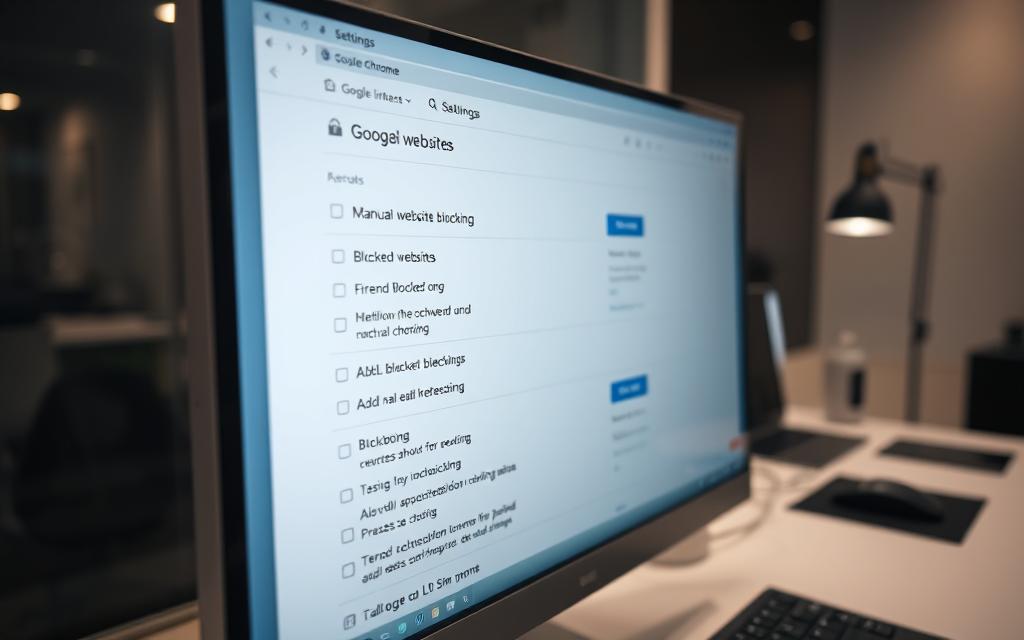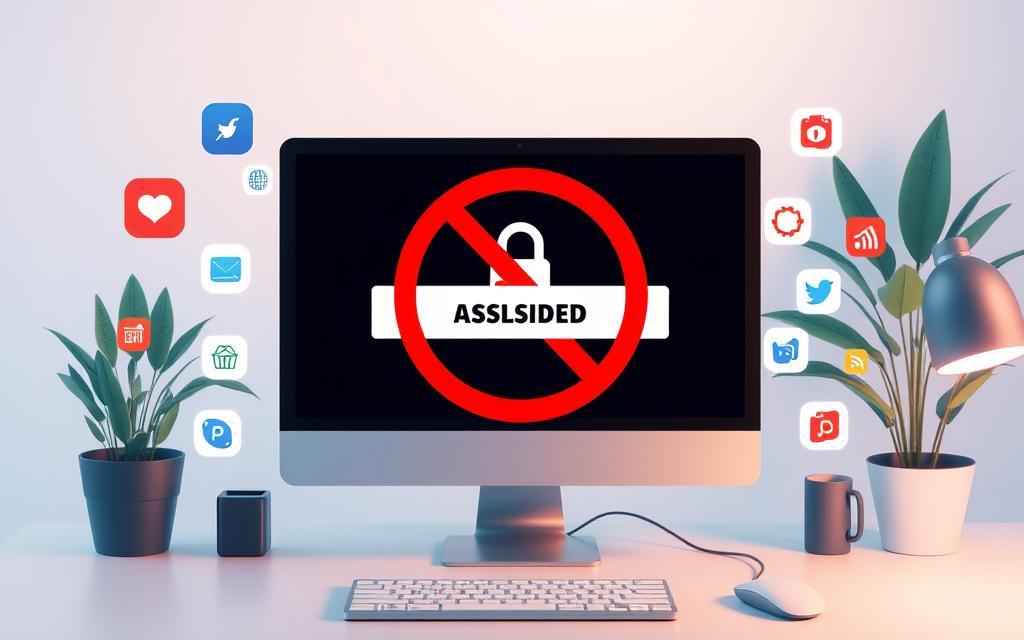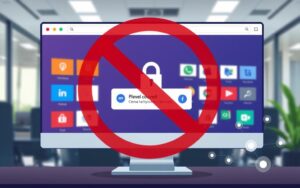Table of Contents
Google Chrome offers various options to block websites and boost online security and productivity. You can restrict access to distracting sites, filter inappropriate content, and manage website access for multiple devices.
This guide will show you how to block websites on Chrome for PC. You’ll learn to take control of your browsing experience effectively.
We’ll cover simple extension installations, advanced router setups, and Google Admin Console settings. These solutions will help you block websites on Chrome efficiently.
By the end, you’ll have the know-how to block sites effectively. This will ensure a more focused, safe, and personalised online experience.
Understanding Website Blocking in Chrome
Website blocking in Google Chrome serves many purposes. It protects children from inappropriate content and boosts workplace productivity. Chrome’s built-in features offer basic content filtering capabilities.
Blocking websites can provide a more robust solution. It prevents access to malicious sites and reduces distractions. This creates a safer browsing environment for users of all ages.
Why Block Websites on Chrome?
Blocking websites on Google Chrome can offer several key benefits:
- Enhance online safety by restricting access to inappropriate or harmful websites
- Improve productivity by limiting distractions and time-wasting activities during work or study
- Strengthen Chrome security by blocking access to malicious or suspicious websites that could compromise system security
- Customise the browsing experience to suit individual or organisational content restrictions
Benefits of Website Blocking
Blocking websites on Google Chrome can offer a range of benefits, including:
- Improved focus and productivity by reducing distractions
- Enhanced online safety, especially for children and young users
- Increased protection against malware, phishing, and other cyber threats
- Customisation of the browsing experience to meet individual or organisational needs
Chrome’s Built-in Security Features
Google Chrome provides several built-in security features. These help users manage website access and content restrictions.
| Feature | Description |
|---|---|
| SafeSearch | Filters search results to exclude explicit sexual or violent content |
| Site Permissions | Allows users to control access to features like camera, location, and notifications |
| Taskbar Badging | Displays the number of unread notifications in the Chrome icon on the taskbar |
These built-in features offer basic website blocking and content control. However, users may need more advanced solutions for specific needs.
Advanced solutions can better address online safety and productivity enhancement requirements. They provide more tailored protection and control.
Using Chrome Extensions for Website Blocking
Chrome extensions like BlockSite provide easy-to-use solutions for website blocking. BlockSite boasts a 4.7 out of 5 rating from 146 users. Over 30,000 people use it to boost their workflow and planning.
Installing BlockSite Extension
Adding BlockSite to Chrome is a breeze. Just pop over to the Chrome Web Store and click ‘Add to Chrome’. The process is quick and simple.
Setting Up Website Restrictions
After installation, blocking websites is straightforward. Click the BlockSite icon on the page you want to block. Or, type URLs into the extension’s dashboard.
The free version lets you block three websites. For more blocks and features, you can upgrade to premium. This includes scheduling, redirects, and password protection.
Managing Blocked Sites
BlockSite makes it easy to manage your blocked websites. You can add, edit, or remove sites from your blocklist whenever needed. This helps keep your focus sharp and productivity high.
| Extension | Average Rating | User Base | Key Features |
|---|---|---|---|
| BlockSite | 4.7/5 | 30,000+ | URL blocking, scheduling, password protection, redirect options |
| Other Extensions | 4.8, 4.6, 3.9, 4.4, 4.7, 5.0 | 3 to 29,000+ ratings | Keyword blocking, white/blacklists, focus modes, Pomodoro techniques |
How to Block a Website on PC Google Chrome
Google Chrome lacks a built-in feature for users to block websites manually. However, you can still manage your browsing and restrict access to specific sites. Adjusting Chrome’s settings can help limit distractions and unwanted content.
Here’s how to customise your Chrome settings:
- Open the Google Chrome browser on your PC.
- Click on the three-dot menu icon in the top-right corner and select “Settings”.
- In the Settings menu, navigate to the “Privacy and security” section.
- Click on “Site settings” to access the various content and permission controls.
- Explore the options to block pop-ups, disable notifications, and manage third-party cookies. Adjust these settings according to your preferences to enhance your browsing experience.
For more thorough manual website blocking, try using third-party Chrome extensions. You could also explore URL restrictions and browser configuration options.
“3 out of 4 parents believe that social media distracts students significantly, according to a report from Rice University.”
The BlockSite extension is a popular tool for blocking distracting websites. It helps you manage your online time more effectively. Using BlockSite with your Chrome settings can create a more focused browsing environment.

These steps can improve your website blocking on Google Chrome. For more advanced options, consider router-level URL restrictions or administrative controls. These provide comprehensive browser configuration and content management.
Advanced Website Blocking Through Router Settings
Blocking websites at the router level boosts network-wide restrictions. This method enhances Wi-Fi security and protects all connected devices. You can use URL filtering to block specific websites or content categories.
Accessing Router Configuration
First, access your router’s admin page. Enter the router’s IP address in your web browser. Look for security or parental control settings to manage blocked websites.
Implementing URL Restrictions
- Identify the websites or categories of content you wish to block, such as social media, gambling, or adult-oriented sites.
- Enter the specific URLs or website addresses into the router’s blocking settings.
- Save the changes and apply the new restrictions.
The process may vary based on your router model. Check your router’s manual or online support for detailed instructions.
Testing Blocked Websites
After setting up, test the restrictions thoroughly. Visit blocked websites to confirm access is denied. Check connectivity on all network devices.
Router-level blocking needs some technical know-how to set up correctly. However, it offers many benefits for your network.
These include better Wi-Fi security and centralised management. It also protects all devices, regardless of location or browser.
“Blocking websites at the router level can be a powerful way to enforce network-wide restrictions, enhancing Wi-Fi security and safeguarding all devices connected to your home or office network.”
| Method | Effectiveness | Ease of Use | Flexibility |
|---|---|---|---|
| Router-level Blocking | High | Medium | High |
| Browser Extensions | Medium | High | Medium |
| Device-specific Restrictions | Medium | High | Low |
Parental Controls and Website Management
Parents play a vital role in safeguarding their children’s online activities. Modern technology offers excellent website management solutions for this purpose. Windows users can set up child accounts through Microsoft family settings. Google’s Family Link app helps block sites on Chrome across devices.
These tools block specific websites and manage screen time. They also monitor activities, creating a safer online space for children. Family Link offers options to allow all sites or block mature content. Parents can even limit access to approved websites only.
The app’s advanced settings give parents control over website and application permissions. This feature enhances their child’s digital experience. Parents can tailor online access to suit their child’s needs.
There are also popular free Chrome extensions to boost website blocking on Google Chrome. BlockSite, StayFocusd, Freedom, and WasteNoTime offer detailed customisation options. These tools help create a safer online environment for children.
“Empowering parents to take an active role in their children’s online safety is essential in today’s digital landscape.”
Using these tools, parents can ensure a safer, richer online experience for their children. They can protect young minds from harmful content and potential online threats.
Using Google Admin Console for URL Blocking
Google Workspace offers powerful admin controls in the Google Admin Console. These tools help manage and restrict website access for users effectively. Policy admins can use them to enforce organisational rules.
Setting Up Administrative Controls
Admins must access the Google Admin Console to begin. They should navigate to ‘Devices’, then ‘Chrome’, and ‘Settings’. The ‘URL Blocking’ feature is under ‘Users & Browsers’ options.
Managing Organisational Units
The console allows creation of organisational units (OUs). These are groups of users and devices arranged hierarchically. Admins can assign specific URL blocklist policies to different OUs.
This tailoring of website restrictions meets various departmental needs. It also caters to different user groups within the organisation.
Implementing URL Blocklist Policies
Admins can define a list of blocked websites in the ‘URL Blocking’ section. This URL blocklist applies to individual OUs, preventing access to specified sites. Exceptions can be made when necessary.
The Google Admin Console integrates smoothly with Google Workspace. This makes it an efficient solution for enterprise content filtering. Organisations can ensure a secure online environment for employees or students.
| Feature | Benefit |
|---|---|
| URL Blocklist | Administrators can define a list of websites to be blocked across the organisation, ensuring compliance with organisational policy. |
| Organisational Unit Management | Administrators can tailor website restrictions to specific user groups or departments by assigning blocklist policies to different organisational units. |
| Exceptions | Administrators can create exceptions to the blocklist, allowing access to particular sites when necessary. |
Conclusion
Blocking websites on Google Chrome enhances online safety and boosts productivity. Chrome users can customise their browsing experience with various options. These range from user-friendly extensions to advanced administrative controls.
These tools cater to parents worried about children’s internet use. They also help employees reduce distractions and individuals improve focus. The methods discussed offer a flexible approach to website blocking.
Chrome’s built-in security features and extensions like BlockSite create a safer online environment. Administrative settings add another layer of control. Regular updates ensure these measures remain effective.
Google Chrome’s website blocking capabilities offer valuable solutions for online safety. They improve productivity tools and strengthen internet security. Users can tailor their browsing experience to achieve their goals.
By applying these methods, Chrome users can maintain a balanced approach to their digital lives. They can create a healthier and more productive online environment.
FAQ
What methods does Chrome offer to block websites?
Chrome provides several ways to block websites. These include extensions, parental controls, and administrative settings. Each method offers unique features for different needs.
What are the purposes of blocking websites in Chrome?
Blocking websites in Chrome serves various important purposes. It protects children from unsuitable content and boosts workplace productivity. Additionally, it enhances online security for all users.
Can I block websites directly in Chrome settings?
Chrome lacks a built-in feature for users to block websites directly. However, you can adjust settings to manage permissions and prevent pop-ups. You can also disable notifications and block third-party cookies for added control.
How can I block websites using a Chrome extension?
Chrome extensions like BlockSite offer easy website blocking solutions. You can block sites by clicking the extension icon on the target website. Alternatively, you can manually enter URLs in the extension’s dashboard.
How can I block websites through my router settings?
Blocking websites via router settings affects all connected devices. Access your router’s configuration page and find security or parental control settings. Add blocked URLs there, but note the process varies by router model.
How can I use parental controls to manage website access?
Parental controls offer thorough website management for children’s online safety. Windows users can set up child accounts and manage content filters through Microsoft family settings. Google’s Family Link app allows blocking sites on Chrome across devices.
How can I use Google Admin Console to block websites?
Google Admin Console offers powerful tools for organisational website blocking. Administrators can create URL blocklists for multiple devices and users. Access the console, find the appropriate settings, and add the URLs you want to block.









